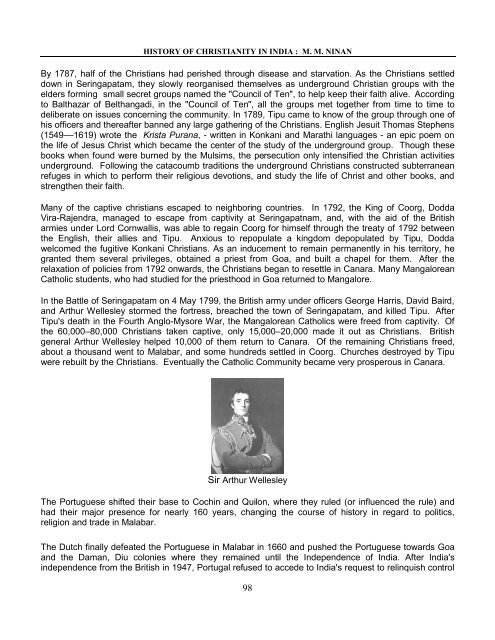Indian Christianity
Create successful ePaper yourself
Turn your PDF publications into a flip-book with our unique Google optimized e-Paper software.
HISTORY OF CHRISTIANITY IN INDIA : M. M. NINAN<br />
By 1787, half of the Christians had perished through disease and starvation. As the Christians settled<br />
down in Seringapatam, they slowly reorganised themselves as underground Christian groups with the<br />
elders forming small secret groups named the "Council of Ten", to help keep their faith alive. According<br />
to Balthazar of Belthangadi, in the "Council of Ten", all the groups met together from time to time to<br />
deliberate on issues concerning the community. In 1789, Tipu came to know of the group through one of<br />
his officers and thereafter banned any large gathering of the Christians. English Jesuit Thomas Stephens<br />
(1549––1619) wrote the Krista Purana, - written in Konkani and Marathi languages - an epic poem on<br />
the life of Jesus Christ which became the center of the study of the underground group. Though these<br />
books when found were burned by the Mulsims, the persecution only intensified the Christian activities<br />
underground. Following the catacoumb traditions the underground Christians constructed subterranean<br />
refuges in which to perform their religious devotions, and study the life of Christ and other books, and<br />
strengthen their faith.<br />
Many of the captive christians escaped to neighboring countries. In 1792, the King of Coorg, Dodda<br />
Vira-Rajendra, managed to escape from captivity at Seringapatnam, and, with the aid of the British<br />
armies under Lord Cornwallis, was able to regain Coorg for himself through the treaty of 1792 between<br />
the English, their allies and Tipu. Anxious to repopulate a kingdom depopulated by Tipu, Dodda<br />
welcomed the fugitive Konkani Christians. As an inducement to remain permanently in his territory, he<br />
granted them several privileges, obtained a priest from Goa, and built a chapel for them. After the<br />
relaxation of policies from 1792 onwards, the Christians began to resettle in Canara. Many Mangalorean<br />
Catholic students, who had studied for the priesthood in Goa returned to Mangalore.<br />
In the Battle of Seringapatam on 4 May 1799, the British army under officers George Harris, David Baird,<br />
and Arthur Wellesley stormed the fortress, breached the town of Seringapatam, and killed Tipu. After<br />
Tipu's death in the Fourth Anglo-Mysore War, the Mangalorean Catholics were freed from captivity. Of<br />
the 60,000–80,000 Christians taken captive, only 15,000–20,000 made it out as Christians. British<br />
general Arthur Wellesley helped 10,000 of them return to Canara. Of the remaining Christians freed,<br />
about a thousand went to Malabar, and some hundreds settled in Coorg. Churches destroyed by Tipu<br />
were rebuilt by the Christians. Eventually the Catholic Community became very prosperous in Canara.<br />
Sir Arthur Wellesley<br />
The Portuguese shifted their base to Cochin and Quilon, where they ruled (or influenced the rule) and<br />
had their major presence for nearly 160 years, changing the course of history in regard to politics,<br />
religion and trade in Malabar.<br />
The Dutch finally defeated the Portuguese in Malabar in 1660 and pushed the Portuguese towards Goa<br />
and the Daman, Diu colonies where they remained until the Independence of India. After India's<br />
independence from the British in 1947, Portugal refused to accede to India's request to relinquish control<br />
98


















